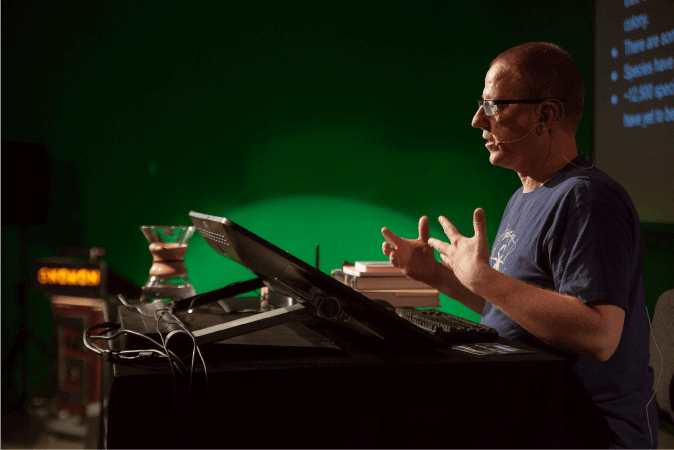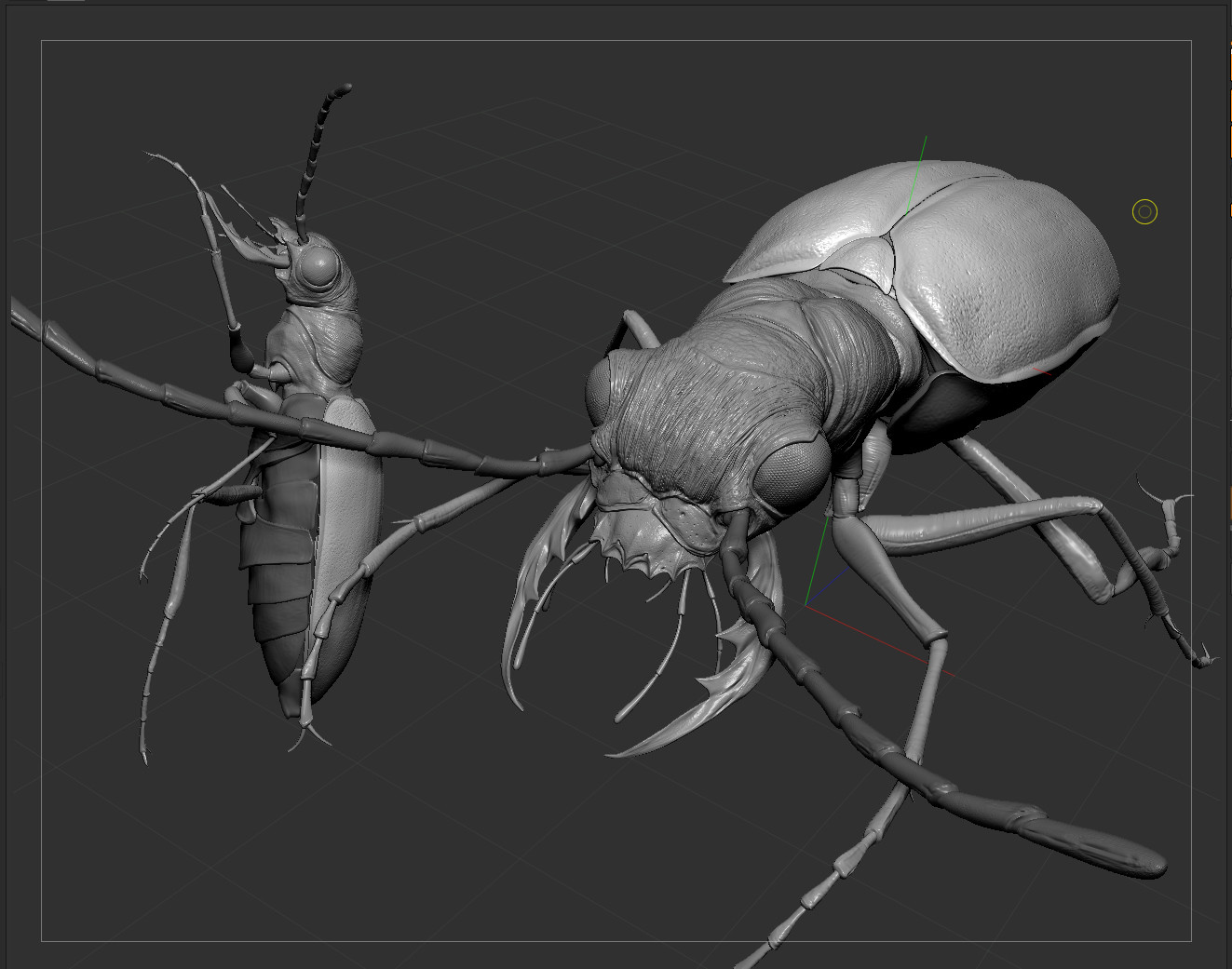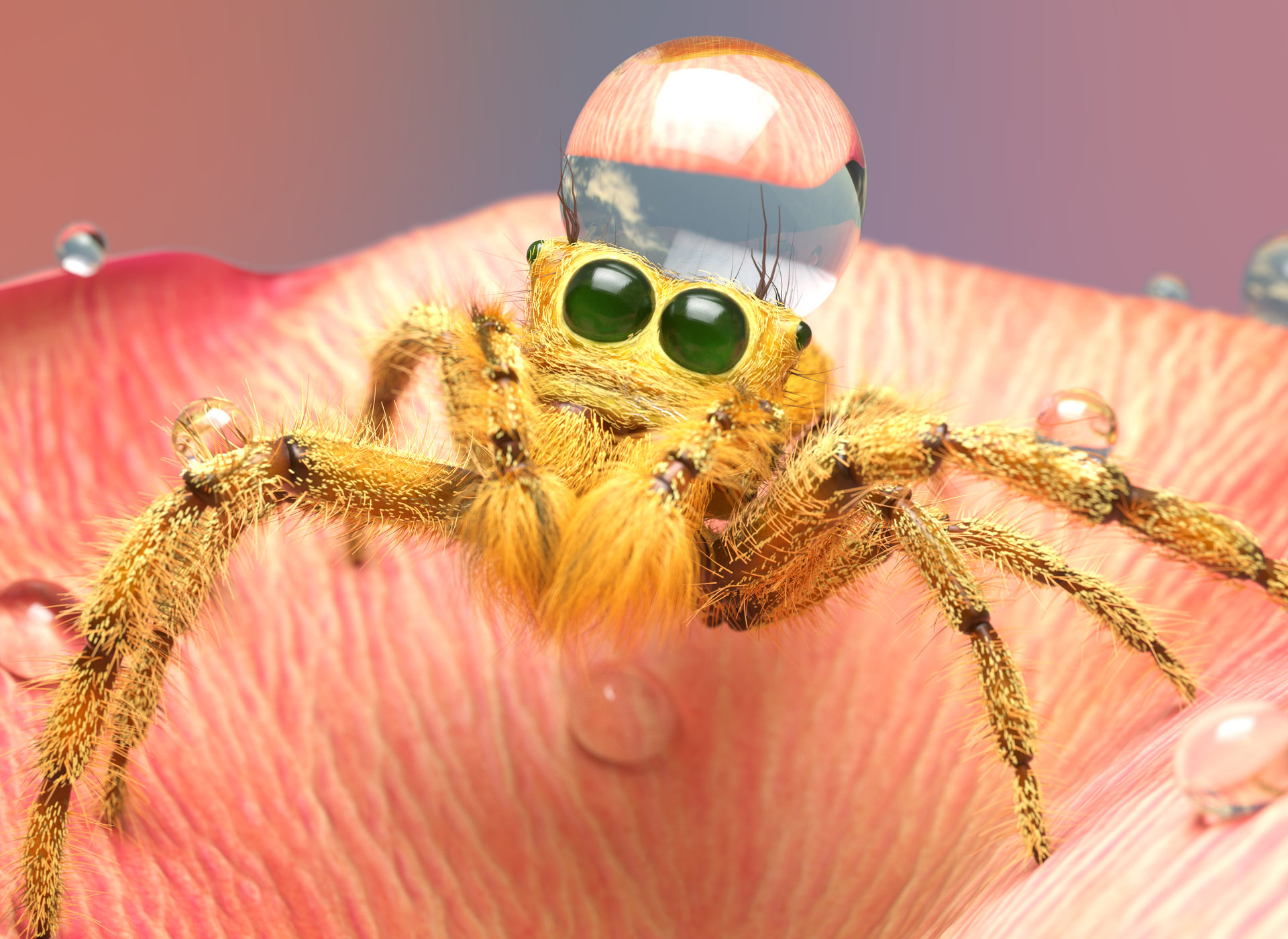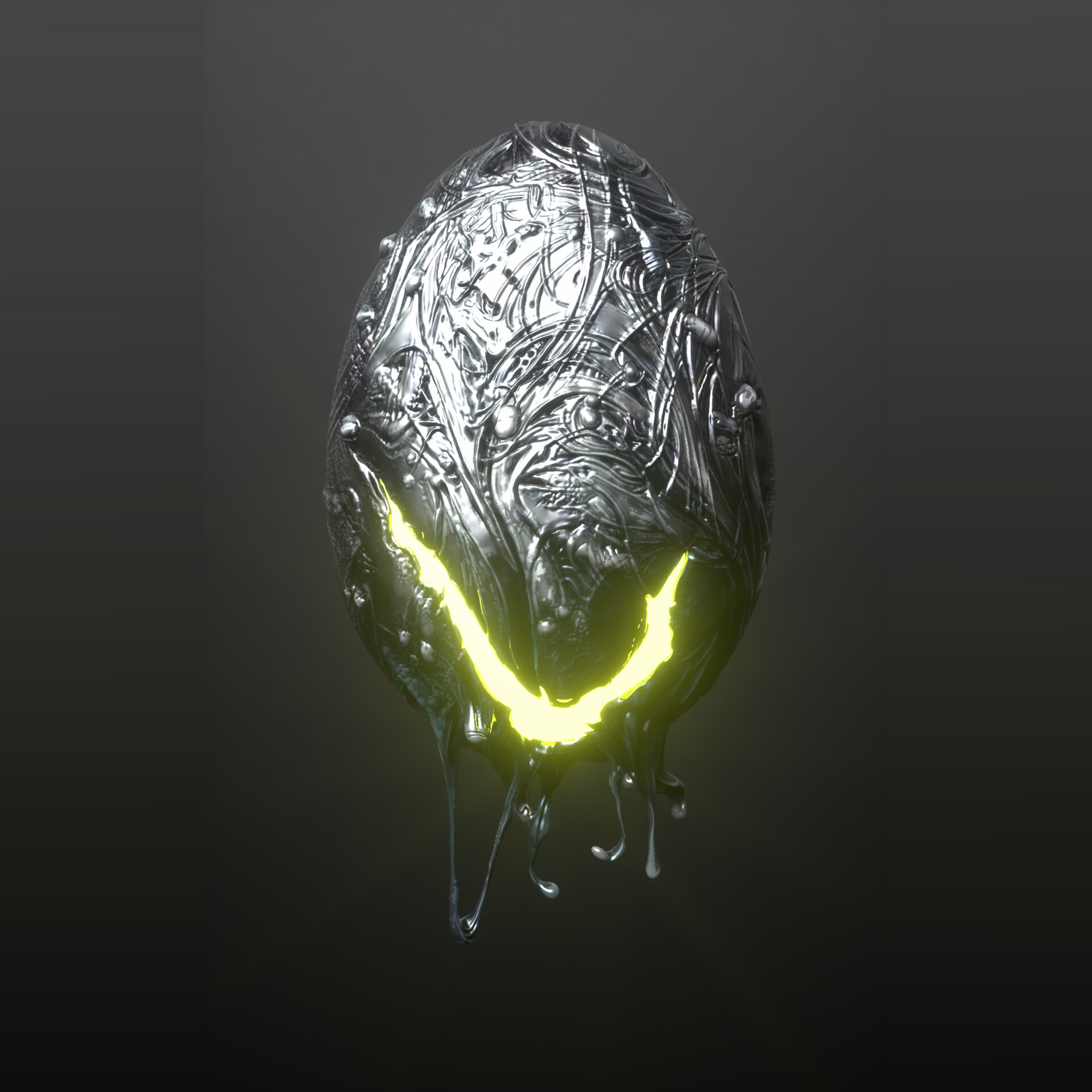The fun (and not-so-fun) challenges of Eric Keller, the CG artist who straddles a creative line between entertainment (Aquaman and John Wick 3) and the bold future of scientific visualization.

I’ve been doing professional CG work for a little over 20 years now and my career is weirdly split between entertainment and scientific visualization. I kind of bounce between the two on a regular basis. When I started way back in 98, I was working for the Howard Hughes Medical Institute, which sounds ridiculous, but is an actual place—like the original Gates Foundation but created by Howard Hughes way back when. It’s actually one of the most prestigious scientific philanthropy organizations in the world even though it was founded by a rather kooky dude. I did a lot of animations for scientific visualization there. Then, in 2005, I moved out here to Los Angeles mainly to attend the Gnomon School (of Visual Effects) and I ended up actually teaching there for 10 years—ZBrush, Maya, etc. I was also working for various studios (sometimes freelance, sometimes as staff) and also doing some scientific work as well—back and forth.
A lot of smaller studios doing film, commercials, and TV work. One of the cooler places I worked was Bad Robot (10 Cloverfield Lane, Star Trek Beyond) doing modeling and texturing in 2015. Sometimes I work on site, but I do a lot of projects largely from my home studio where I have my shiny new BOXX machine which I love very much. For the past year, during the day, I’ve been working at the Griffith Observatory in Los Angeles on a fully CG planetarium show that will be released in 2020. In the evenings I’ve been working for studios such as Filmograph on projects including the title sequences for Aquaman, John Wick 3, and Swamp Thing. I’ve been doing a lot of feature film title sequences with my BOXX and it’s fun work. Filmograph allows me a fair amount of creative input in the CG assets I create for them.
Based on the times I have now versus a cloud test, we have helped everyone to understand. Joking around one day I said to an IT Director, “I’ll tell you what, when George Lucas decides to switch Industrial Light & Magic over to a cloud-based system or when Digital Domain does it, I will agree and submit to adding mine to the cloud, but considering they just built new campuses and have run hundreds of thousands of miles of network cable to all the processors and the render farm, I don’t think that will happen for quite some time.” So, George if you’re reading this please, please take your time.
That’s a good example. Filmograph has a small team based in Echo Park but they also have artists spread out all over the place. Mostly what I’ve been doing for them lately is modeling and texturing, so with the models of the statues of the ladies, the Atlantis Greek statues, a lot of the compasses, and mermaid type of stuff, they give me the initial concept art and guidelines for design. Sometimes it might be a series of pictures meaning “We want something that looks like this, we want this kind of coral on it, or something that suggests this.”
I usually start in ZBrush. Sometimes I get assets in Maya that I then take into ZBrush because it’s usually my starting place. I have an older 24 HD Wacom Cintiq hooked up to the BOXX. I have ZBrush and Maya, which are my two main tools. I have Photoshop and other things like that, but most of the time I’m in ZBrush and Maya. So I start sculpting away and post some updates when we get closer to something they like. They usually say, “Go with that,” and I’ll do more of the posing, the detailing, the UV mapping, sometimes texturing in substance and I’ll do test renders using Octane Renderer, Arnold, or whatever and I’ll send that over to them and when they approve the design, it is usually a really fast turnaround. At the most, I may have three or four evenings to work on a particular asset. I have to turn it around really quickly so they can hand it off to whoever is doing the main layout, animation, and camerawork. They’ll render and put it together. So that’s kind of typical—also like what I did on John Wick 3. Sometimes I do the animation and effects, but these days, it’s mostly the modeling and texturing and that’s the part I like best anyway.
Projects I’ve worked on with Filmograph include Power Rangers, Aquaman, The Haunting of Hill House, Overlord, Krampus, Why Him?, Swamp Thing, and branding for Romulus Entertainment, Atomic Monster, and Blinding Edge.
I was working at Prologue Films around 2008 and they worked there as well—some fun stuff, some really difficult not-so-fun stuff, but we bonded over that and then they started their own studio (Filmograph) a few years later. They call when they need help on a project. That’s basically the way it works. I hang out with them too because they’re my good friends.

In my spare time, I’m working on scientific visualization. My specialty is creating insects and arachnids. Entomology is one of my favorite topics. For this, I’m doing more and more with the Unreal game engine. I really like the idea of doing real-time rendering, so I’ve been experimenting using Unreal as an animation and rendering package. My friend Mark Dedecker has been building interactive controls so that eventually a user can drive the spiders and insects using a game controller.
For scientific visualization, most of what I do is biology instruction for students. Much of it has to do with insect models, so I’ll be asked to do a specific species or I’ll decide to do one on my own and gather as much reference as I can. I just did a rainbow scarab beetle. I get kind of insane about reference, for example, last year I went to Africa to take pictures with a macro-photography group to get the best possible reference. Also, because I like to hang out with scientists because they’re awesome people, and Africa is very cool. Sometimes my reference is just pictures, sometimes its pictures and diagrams, and I’ll bring those images into ZBrush and start sculpting away. I also use YouTube videos created by entomologists. Andreas Kay has some amazing You Tube videos.
I have a microscope by my desk in case I can get a dead specimen to look at. (My wife gets really excited about this—as you can imagine) I sculpt as best I can, take them into Maya, retool, do some UV work, rig them, and then use substance to paint texture –Substance Painter (3D painting software) and also Substance Designer. I then either bring them into Unreal to create a real-time asset or render them out of Maya using Octane or Arnold. Sometimes, if I’m doing a specific thing for a scientist, they’ll send me reference material, sketches, and storyboards. Sometimes, they’re really great. Sometimes they look like scribbles because the scientist is not a very visual person and I have to educate them on the process for animation.
The entertainment projects are like what I described for Aquaman. That’s the most typical workflow. Sometimes we’ll get assets from the studio and we’ll use that as a basis for designing. But sometimes, they’re not crazy about doing that—as you can imagine. I do a lot of what I mentioned regarding autonomy. Sometimes they’re very specific about what they want and a lot of the time it’s a general idea and they’ll let me create a bunch of different poses for the models. They’ll kind of work with that based on their storyboards and their camera animation. That’s pretty much it. I haven’t done as much rendering at home as I used to do, which is pretty cool. I’ve done a lot with Octane and I’m just getting into Redshift. I’m very interested in GPU rendering. If you’re like me and doing a lot of small projects in your own home studio, the GPU is the way to go—much faster turnaround and it looks beautiful.
A few years ago, Apple did a major project for the iPad. It was one of Steve Jobs’ last big ideas and he wanted to reinvent the textbook. When the iPad was first introduced, Apple worked with E.O. Wilson, a famous Harvard scientist, evolutionary biologist, and entomologist. Apple hired Wilson’s foundation to do this iPad biology textbook so we did countless models and animations. More and more, I’m getting requests for VR, and I’d like to get into AR as well. So that is sort of on the horizon. Some projects are meant for the web or as a curriculum biology course and then there is some stuff we’re doing for pharmaceuticals like patient education or demonstrations. I haven’t done one of those in a while but that’s where a lot of the work in science visualization is. Pharmaceutical companies tend to not be as excited about insects as I am (laughs). The audience I most often create for tends to be more biology students –high school or undergrad. I’ve also done projects for the Natural History Museum in LA. Some of that is just for fun.

Mostly freelance. When I did the book for Apple I worked with Digizyme inc. Digizyme is a leader in scientific visualization. Its founder, Gael McGill, is a good friend of mine. I’ve worked with them for over ten years. These days it’s mostly freelance contract work.
I was a failed musician first (laughs).
(Laughs). It’s a common thread in the industry. I studied music in school and when I got out I waited tables for a while and that was no fun. Then one day I played around with 3D software and said, “This is what I want to do for the rest of my life”. I didn’t even know if it was a possibility back then in 1995.
Quite literally. I rendered a chrome sphere in Ray Dream Designer, almost by accident, and my mind was blown. It felt like I had just split the atom.
Photoshop had just gotten layers –brave new world (laughs). I was in Washington, DC at the time, so you can imagine the 1995 DC market for CG artists was really small. I managed to get a job doing web stuff because the internet was blowing up and at the Hughes Institute they’re a bunch of scientists and they were working on their science education website. But they also hired me because I had a few goofy little 3D animation videos on my website. They wanted to create 3D as well. My two bosses, Dennis Liu and Satoshi Amagai, became my good friends—still are. Aside from the web stuff, we had a little SGI, little blue toasters and version one of Maya on it. They had this because they had a lot of money, and back then Maya was like 17k or something ridiculous. They basically said, “Put together these animations for these lecture series.” So that’s when I started doing 3D professionally, 1998, making bacteria, hearts, etc.
I loved the science aspect—working with scientists. I also liked science communication which is definitely a passion of mine. Around 2005, it was time to do something else. I was also dissatisfied with doing one or two animations a year. I wanted to do one or two a week. That’s when Gnomon came into its own so I really wanted to go there and study. I dragged my wife out here to California, took classes, wrote articles, some books on Maya and ZBrush, and convinced Gnomon to let me teach ZBrush and Maya intro courses and then creature sculpting classes. Did that for a while and now I work on my own projects. My wife ended up really enjoying living in LA, now we have a house in Eagle Rock.
Fun challenges and not-so-fun challenges. How to sculpt a particular object in Aquaman is a fun challenge. The not fun is usually the rendering. I’m going between GPU rendering and Unreal game engine stuff, but that’s my strategy—to get as far away from batch rendering as I can if I’m working at home. That leads to why I got a BOXX with a couple of (NVIDIA GeForce) Titans in it. You have to just sit there and let your machine cook and you’re not getting anything done during that time. It’s not like I want to start charging people for a minute of rendering ‘cause that’s lame. I’ve dealt with that by going to GPU or game engine stuff or letting the studio handle it. But my BOXX machine is nice and fast whether I’m doing real-time GPU rendering or CPU rendering which makes rendering a much more pleasant experience.
A long time ago I went through a phase with Apple, but then they abandoned artists so I’m not crazy about them anymore. I have one Mac still up and it is largely my web browsing, Spotify- listening machine. I had a BOXX a few years ago and I liked it a lot. I used it for six or seven years and it’s still in my studio. Then, I did what all CG artists do, because everyone says, “You gotta’ make your own machine.” I’m terrible at putting that stuff together because when things don’t work, I go crazy. I just want things to WORK. So I had a friend of mine build me a machine and it was a perfectly fine machine, but you know when you get someone to build a machine there’s always weird things that it does. So you think, “That’s not what it should be doing right now.” Then there is the fear of what if something happens to it? What are you going to do? Call up the guy five years later?
(Laughs). You’re going to get a dead phone number like you’ve been ghosted or whatever. So I did that one time . . . and also the machine was massive, it was like a freakin’ refrigerator. So when it got old, like four or five years, I didn’t even search around. I said, “I’m calling BOXX.” I talked to (BOXX performance specialist) Joe Matthews and another reason I like BOXX so much is you guys understand 3D artists and that’s the most important thing. I can’t go into the Apple store and talk about Maya or ZBrush. They just kind of blink at you. Friends or yourself making it—that’s just not reliable. With BOXX, it’s “This is what I need, this is what I want” and you guys gave me a price quote, set me up with a machine. I get it, I plug it in, and it works perfectly and that’s why I love it so much. I just have a little extra RAM I’m going to throw in. I’ve had it since last summer and it still feels like new. It’s a great little machine. If I have a problem or a question, I get an answer from you guys within an hour, which is great. I’ve never needed tech support.
One year I went to SIGGRAPH and I met some of your reps at the BOXX booth and I was impressed. I was impressed because you were talking 3D from day one. At the time I was using an Alienware. It was big and yellow. Beyond that it was . . . it never felt like a professional machine.

This may sound like a small thing but it’s not. Part of it is peace of mind—knowing that when I have a tight deadline, I don’t have to worry about my machine working. That’s a big deal. Or I know if I run into a problem, I can call you guys. I have full confidence in BOXX and that’s a huge deal because I don’t need added stress on top of everything else, and deadlines are always shifting.
The overall speed of the machine working in Maya and ZBrush is really great and with the GPU rendering, a few months ago, I got to create the 40th anniversary cover of the Alien box set. It was a big, creepy alien egg but they wanted it in chrome. I knocked that out so fast, I don’t even want to say how fast it was. They asked for a time budget, some referenced images, and I knocked it out so fast because I was able to sculpt it really quickly in ZBrush then render it using Octane on my BOXX. A couple of iterations and it was done.
Yes, and sometimes it means I have to work all day long doing animations at the planetarium, come home, eat dinner, then spend four or five hours at night working on a Filmograph project or whatever. We usually agree on the deadline and then two or three days later I get an email saying the deadline has been pushed up. And you knock it out. That’s how this week has been. It’s all about the fast turnaround and the BOXX machine definitely helps with that.
I think my biggest interest going forward is working with the Unreal game engine stuff and also virtual reality and augmented reality. That means fast GPUs, lots of RAM, a fast machine. I’d like to work mainly from my home studio and see how I can integrate CG with the Unreal engine for science education. Science education is one of the most important things going on today. We need scientifically literate children. Its one thing to create an animation that shows how an ant stings you and that’s a great educational exercise—if the kid is watching. But you know kids. Their attention span is short. In an ideal world, it would be great if the kids made the animation themselves because when they go through the creative process, that’s when they begin to really learn. They actually have to learn insect anatomy or how an ecosystem works. There are some kids, and I was one of them, where the best way they learn is through creativity—actually making something.
Science fiction movies depict the classroom of the future with kids working on holograms. Well, someone has to actually build that in the real world in order for it to happen like we imagine in our sci-fi utopia. We have to get to a situation where it’s no longer a sci fi fantasy thing, but a reality. Find a way to integrate CG into an actual teaching curriculum. You can’t have kids in a classroom batch rendering. They have to work with real-time tools. That’s the only way it’s going to work. I’m not there yet, but trying to slowly build up a proof of concept through creating animations. I have a YouTube video channel called “Entomology Animated” where I show my process for modeling and ZBrush. It’s still at a very CG nerd level, but through exploring the tools, inexpensive powerful tools like Unreal and Unity and other sculpting programs like Sculptris and even Blender, you could see a future, hardware costs aside, of a lot of cheap software which could become available to students. If that point arrives and schools start to embrace that, you need a guide to take them through the process who has actually been doing it for a long time. That’s sort of where I’m going with all this. I like the entertainment stuff, but there are millions of people doing that. There are not enough people saying we have to start using these tools for different purposes, something other than just entertainment. People underestimate the power of giving a student a computer and a blank slate and saying, “Make this,” as opposed to saying, “Watch this goofy little animation or play this game.” Students don’t care about educational games. They will play an educational video game until the teacher walks away and then they’ll switch to the game they actually want to play. I really think using video game authoring is a better approach to education than having kids just play games.
I have a lot of projects on the horizon and I’m not messing with other machines. I’m sticking with BOXX. You guys care about your customers and that’s a big deal. I never feel like you’re trying to sell me something I don’t need. Do you ever try to buy something and it feels like they’re giving you a commercial? It’s not helpful. I don’t get that from BOXX. I get, “This is what you want to do? Let’s work together to get you the best system for that.” That’s a big benefit. It’s more like a partnership instead of just sales. Know what I mean? It’s cool.
CPU:Eight-core AMD Ryzen Threadripper
GPUs:Two NVIDIA GeForce GTX 1080TI graphics cards
System memory:32GB
Storage:1 1.0TB SSD M.2 PCIe Drive
Hard drives:2.0TB 7,200rpm SATA 6Gb/s